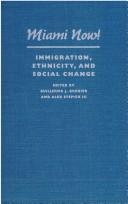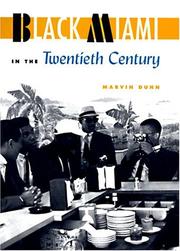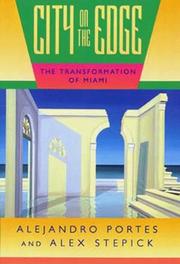| Listing 1 - 10 of 15 | << page >> |
Sort by
|

ISBN: 0671646648 Year: 1987 Publisher: New York
Abstract | Keywords | Export | Availability | Bookmark
 Loading...
Loading...Choose an application
- Reference Manager
- EndNote
- RefWorks (Direct export to RefWorks)
American literature --- Cuban Americans --- Cubans --- Ethnology --- Miami (Fla.) --- City of Miami (Fla.) --- ميامي (Fla.) --- Mayāmī (Fla.) --- Mīyāmī (Fla.) --- Маями (Fla.) --- Mai︠a︡mi (Fla.) --- Μαϊάμι (Fla.) --- Miamo (Fla.) --- 마이애미 (Fla.) --- Maiaemi (Fla.) --- Майами (Fla.) --- מיאמי (Fla.) --- Miamia (Fla.) --- Majamis (Fla.) --- Мајами (Fla.) --- Majami (Fla.) --- マイアミ (Fla.) --- Маямі (Fla.) --- 迈阿密 (Fla.) --- Social conditions. --- Florida --- Social conditions
Book
ISBN: 1137575239 1137570458 Year: 2016 Publisher: New York : Palgrave Macmillan US : Imprint: Palgrave Macmillan,
Abstract | Keywords | Export | Availability | Bookmark
 Loading...
Loading...Choose an application
- Reference Manager
- EndNote
- RefWorks (Direct export to RefWorks)
This book explores the reception experiences of post-1958 Afro-Cubans in South Florida in relation to their similarly situated “white” Cuban compatriots. Utilizing interviews, ethnographic observations, and applying Census data analyses, Aja begins not with the more socially diverse 1980 Mariel boatlift, but earlier, documenting that a small number of middle-class Afro-Cuban exiles defied predominant settlement patterns in the 1960 and 70s, attempting to immerse themselves in the newly formed but ultimately racially exclusive “ethnic enclave.” Confronting a local Miami Cuban “white wall” and anti-black Southern racism subsumed within an intra-group “success” myth that equally holds Cubans and other Latin Americans hail from “racial democracies,” black Cubans immigrants and their children, including subsequent waves of arrival and return-migrants, found themselves negotiating the boundaries of being both “black” and “Latino” in the United States.
Ethnology-Latin America. --- Cuban Americans --- Cubans --- Blacks --- History. --- Negroes --- Ethnology --- Latin American Culture. --- Ethnology—Latin America. --- Miami (Fla.) --- Florida --- City of Miami (Fla.) --- ميامي (Fla.) --- Mayāmī (Fla.) --- Mīyāmī (Fla.) --- Маями (Fla.) --- Mai︠a︡mi (Fla.) --- Μαϊάμι (Fla.) --- Miamo (Fla.) --- 마이애미 (Fla.) --- Maiaemi (Fla.) --- Майами (Fla.) --- מיאמי (Fla.) --- Miamia (Fla.) --- Majamis (Fla.) --- Мајами (Fla.) --- Majami (Fla.) --- マイアミ (Fla.) --- Маямі (Fla.) --- 迈阿密 (Fla.) --- Race relations

ISBN: 0813021634 9780813021638 081301154X 0813011558 Year: 1992 Publisher: [Place of publication not identified] University Press of Florida
Abstract | Keywords | Export | Availability | Bookmark
 Loading...
Loading...Choose an application
- Reference Manager
- EndNote
- RefWorks (Direct export to RefWorks)
Minorities --- United States Local History --- Regions & Countries - Americas --- History & Archaeology --- Ethnic minorities --- Foreign population --- Minority groups --- Persons --- Assimilation (Sociology) --- Discrimination --- Ethnic relations --- Majorities --- Plebiscite --- Race relations --- Segregation --- Miami (Fla.) --- Race relations. --- Ethnic relations. --- Social conditions. --- City of Miami (Fla.) --- ميامي (Fla.) --- Mayāmī (Fla.) --- Mīyāmī (Fla.) --- Маями (Fla.) --- Mai︠a︡mi (Fla.) --- Μαϊάμι (Fla.) --- Miamo (Fla.) --- 마이애미 (Fla.) --- Maiaemi (Fla.) --- Майами (Fla.) --- מיאמי (Fla.) --- Miamia (Fla.) --- Majamis (Fla.) --- Мајами (Fla.) --- Majami (Fla.) --- マイアミ (Fla.) --- Маямі (Fla.) --- 迈阿密 (Fla.)

ISBN: 0813021472 9780813021478 0813015308 Year: 1997 Publisher: Gainesville University Press of Florida
Abstract | Keywords | Export | Availability | Bookmark
 Loading...
Loading...Choose an application
- Reference Manager
- EndNote
- RefWorks (Direct export to RefWorks)
African Americans --- Regions & Countries - Americas --- History & Archaeology --- United States Local History --- Afro-Americans --- Black Americans --- Colored people (United States) --- Negroes --- Africans --- Ethnology --- Blacks --- History --- Miami (Fla.) --- City of Miami (Fla.) --- ميامي (Fla.) --- Mayāmī (Fla.) --- Mīyāmī (Fla.) --- Маями (Fla.) --- Mai︠a︡mi (Fla.) --- Μαϊάμι (Fla.) --- Miamo (Fla.) --- 마이애미 (Fla.) --- Maiaemi (Fla.) --- Майами (Fla.) --- מיאמי (Fla.) --- Miamia (Fla.) --- Majamis (Fla.) --- Мајами (Fla.) --- Majami (Fla.) --- マイアミ (Fla.) --- Маямі (Fla.) --- 迈阿密 (Fla.) --- Race relations. --- Race relations --- Florida --- 20th century --- Black people
Book
ISBN: 9780983820482 0983820481 Year: 2013 Publisher: New York Clog
Abstract | Keywords | Export | Availability | Bookmark
 Loading...
Loading...Choose an application
- Reference Manager
- EndNote
- RefWorks (Direct export to RefWorks)
"The largest city in the southeastern United States, Miami has long been subject to a range of unique forces--natural, political, and cultural--which have brought both booms and devastating busts. Despite setbacks, however, Miami has become a dynamic and broadly American city that mixes the historically Anglo-dominated North and the Latin South, vividly presenting many characteristics of today's United States: cosmopolitanism, an ever- shifting balance between public and private interests, economic volatility, and environmental tightrope walking. When it comes to architecture, something is definitely happening in Miami. Not only is real estate and development booming, but recently, significant civic projects have demonstrated a potentially serious public/private commitment to infuse the commons with design and the arts, as seen in the Wynwood Art District and Art Basel Miami. Miami invented a strand of mid- century Modernism, epitomized the design aesthetic of the 1980s, hosted the major intellectual center of the New Urbanism movement, and is now providing opportunities to a new (and hungry) crop of international architects in projects like the Miami Beach Convention Center, Coconut Grove, the New World Center, One Thousand Museum Tower, the Perez Art Museum Miami, 1111 Lincoln Road, and more. This issue presents the beginning of a critical discussion on contemporary architecture in a city with a short but vibrant past and exciting future--Miami"--Provided by publisher.
Architecture --- 711.4(C)(73) --- Steden ; vormgeving ; analyse ; 21ste eeuw ; Miami --- Steden ; Miami --- Architecture, Western (Western countries) --- Building design --- Buildings --- Construction --- Western architecture (Western countries) --- Art --- Building --- Stedenbouw. Ruimtelijke ordening ; vormgeving en analyse van de stad ; Verenigde Staten --- Design and construction --- Miami (Fla.) --- Buildings, structures, etc. --- Architecture. --- Buildings. --- Florida --- City of Miami (Fla.) --- ميامي (Fla.) --- Mayāmī (Fla.) --- Mīyāmī (Fla.) --- Маями (Fla.) --- Mai︠a︡mi (Fla.) --- Μαϊάμι (Fla.) --- Miamo (Fla.) --- 마이애미 (Fla.) --- Maiaemi (Fla.) --- Майами (Fla.) --- מיאמי (Fla.) --- Miamia (Fla.) --- Majamis (Fla.) --- Мајами (Fla.) --- Majami (Fla.) --- マイアミ (Fla.) --- Маямі (Fla.) --- 迈阿密 (Fla.) --- Architecture, Primitive

ISBN: 0520915542 0585249849 9780520915541 9780585249841 0520082176 0520089324 Year: 1993 Publisher: Berkeley University of California press
Abstract | Keywords | Export | Availability | Bookmark
 Loading...
Loading...Choose an application
- Reference Manager
- EndNote
- RefWorks (Direct export to RefWorks)
Winner, 1995 American Sociological Association Robert E. Park Award? Projecting fantasies of wealth and excess, Miami, "America's Riviera," occupies a unique place in our national imagination. Uncovering the hidden story of this dreamlike place, Portes and Stepick explore the transformations of Miami from a light-hearted tourist resort to a troubled, complex city.
Minorities --- Regions & Countries - Americas --- History & Archaeology --- United States Local History --- Ethnic minorities --- Foreign population --- Minority groups --- Persons --- Assimilation (Sociology) --- Discrimination --- Ethnic relations --- Majorities --- Plebiscite --- Race relations --- Segregation --- Miami (Fla.) --- City of Miami (Fla.) --- ميامي (Fla.) --- Mayāmī (Fla.) --- Mīyāmī (Fla.) --- Маями (Fla.) --- Mai︠a︡mi (Fla.) --- Μαϊάμι (Fla.) --- Miamo (Fla.) --- 마이애미 (Fla.) --- Maiaemi (Fla.) --- Майами (Fla.) --- מיאמי (Fla.) --- Miamia (Fla.) --- Majamis (Fla.) --- Мајами (Fla.) --- Majami (Fla.) --- マイアミ (Fla.) --- Маямі (Fla.) --- 迈阿密 (Fla.) --- Race relations. --- Ethnic relations. --- Social conditions. --- #SBIB:39A4 --- #SBIB:316.334.5U20 --- Toegepaste antropologie --- Sociologie van stad (buurt, wijk, community, stadsvernieuwing) --- Social conditions --- Florida
Book
ISBN: 0813051622 0813055830 9780813055831 9780813062648 0813062640 9780813051628 Year: 2016 Publisher: Gainesville
Abstract | Keywords | Export | Availability | Bookmark
 Loading...
Loading...Choose an application
- Reference Manager
- EndNote
- RefWorks (Direct export to RefWorks)
Combining archival research and oral history, Bush examines Virginia Key Beach as a window into local activism and forms of black-white dialogue in multicultural Miami from 1915 to 2012.
Civil rights --- African Americans --- Afro-Americans --- Black Americans --- Colored people (United States) --- Negroes --- Africans --- Ethnology --- Blacks --- Basic rights --- Civil liberties --- Constitutional rights --- Fundamental rights --- Rights, Civil --- Constitutional law --- Human rights --- Political persecution --- History --- Law and legislation --- Miami (Fla.) --- Virginia Key (Miami, Fla.) --- Virginia Key (Fla.) --- City of Miami (Fla.) --- ميامي (Fla.) --- Mayāmī (Fla.) --- Mīyāmī (Fla.) --- Маями (Fla.) --- Mai︠a︡mi (Fla.) --- Μαϊάμι (Fla.) --- Miamo (Fla.) --- 마이애미 (Fla.) --- Maiaemi (Fla.) --- Майами (Fla.) --- מיאמי (Fla.) --- Miamia (Fla.) --- Majamis (Fla.) --- Мајами (Fla.) --- Majami (Fla.) --- マイアミ (Fla.) --- Маямі (Fla.) --- 迈阿密 (Fla.) --- Race relations --- Black people
Book
ISBN: 1469635216 1469635224 9781469635217 9781469635194 1469635194 9781469635200 1469635208 9798890853134 9781469635224 9798890853127 Year: 2017 Publisher: Chapel Hill : Baltimore, Md. : University of North Carolina Press, Project MUSE,
Abstract | Keywords | Export | Availability | Bookmark
 Loading...
Loading...Choose an application
- Reference Manager
- EndNote
- RefWorks (Direct export to RefWorks)
Poised on the edge of the United States and at the center of a wider Caribbean world, today's Miami is marketed as an international tourist hub that embraces gender and sexual difference. As Julio Capo Jr. shows in this fascinating history, Miami's transnational connections reveal that the city has been a queer borderland for over a century. In chronicling Miami's queer past from its 1896 founding through 1940, Capo shows the multifaceted ways gender and sexual renegades made the city their own. Drawing from a multilingual archive, Capo unearths the forgotten history of "fairyland," a marketing term crafted by boosters that held multiple meanings for different groups of people. In viewing Miami as a contested colonial space, he turns our attention to migrants and immigrants, tourism, and trade to and from the Caribbean--particularly the Bahamas, Cuba, and Haiti--to expand the geographic and methodological parameters of urban and queer history. Recovering the world of Miami's old saloons, brothels, immigration checkpoints, borders, nightclubs, bars, and cruising sites, Capo makes clear how critical gender and sexual transgression is to understanding the city and the broader region in all its fullness.
Sexual minorities --- Gender minorities --- GLBT people --- GLBTQ people --- Lesbigay people --- LBG people --- LGBT people --- LGBTQ people --- Non-heterosexual people --- Non-heterosexuals --- Sexual dissidents --- Minorities --- History --- Caribbean Area --- Miami (Fla.) --- City of Miami (Fla.) --- ميامي (Fla.) --- Mayāmī (Fla.) --- Mīyāmī (Fla.) --- Маями (Fla.) --- Mai︠a︡mi (Fla.) --- Μαϊάμι (Fla.) --- Miamo (Fla.) --- 마이애미 (Fla.) --- Maiaemi (Fla.) --- Майами (Fla.) --- מיאמי (Fla.) --- Miamia (Fla.) --- Majamis (Fla.) --- Мајами (Fla.) --- Majami (Fla.) --- マイアミ (Fla.) --- Маямі (Fla.) --- 迈阿密 (Fla.) --- Caribbean Free Trade Association countries --- Caribbean Region --- Caribbean Sea Region --- West Indies Region --- Emigration and immigration. --- Race relations. --- Queer people
Book
ISBN: 1501738240 1501738259 9781501738258 9781501738265 1501738267 9781501738234 1501738232 Year: 2019 Publisher: Ithaca, NY
Abstract | Keywords | Export | Availability | Bookmark
 Loading...
Loading...Choose an application
- Reference Manager
- EndNote
- RefWorks (Direct export to RefWorks)
The Racial Politics of Division deconstructs antagonistic discourses that circulated in local Miami media between African Americans, "white" Cubans, and "black" Cubans during the 1980 Mariel Boatlift and the 1994 Balsero Crisis. Monika Gosin challenges exclusionary arguments pitting these groups against one another and depicts instead the nuanced ways in which identities have been constructed, negotiated, rejected, and reclaimed in the context of Miami's historical multiethnic tensions. Focusing on ideas of "legitimacy," Gosin argues that dominant race-making ideologies of the white establishment regarding "worthy citizenship" and national belonging shape inter-minority conflict as groups negotiate their precarious positioning within the nation. Rejecting oversimplified and divisive racial politics, The Racial Politics of Division portrays the lived experiences of African Americans, white Cubans, and Afro-Cubans as disrupters in the binary frames of worth-citizenship narratives. Foregrounding the oft-neglected voices of Afro-Cubans, Gosin posits new narratives regarding racial positioning and notions of solidarity in Miami. By looking back to interethnic conflict that foreshadowed current demographic and social trends, she provides us with lessons for current debates surrounding immigration, interethnic relations, and national belonging. Gosin also shows us that despite these new demographic realities, white racial power continues to reproduce itself by requiring complicity of racialized groups in exchange for a tenuous claim on US citizenship.
Ethnic conflict --- Minorities --- Ethnic minorities --- Foreign population --- Minority groups --- Persons --- Assimilation (Sociology) --- Discrimination --- Ethnic relations --- Majorities --- Plebiscite --- Race relations --- Segregation --- Conflict, Ethnic --- Ethnic violence --- Inter-ethnic conflict --- Interethnic conflict --- Social conflict --- Social conditions. --- Miami (Fla.) --- City of Miami (Fla.) --- ميامي (Fla.) --- Mayāmī (Fla.) --- Mīyāmī (Fla.) --- Маями (Fla.) --- Mai︠a︡mi (Fla.) --- Μαϊάμι (Fla.) --- Miamo (Fla.) --- 마이애미 (Fla.) --- Maiaemi (Fla.) --- Майами (Fla.) --- מיאמי (Fla.) --- Miamia (Fla.) --- Majamis (Fla.) --- Мајами (Fla.) --- Majami (Fla.) --- マイアミ (Fla.) --- Маямі (Fla.) --- 迈阿密 (Fla.) --- Race relations. --- Ethnic relations.
Book
ISBN: 1626373817 1626370419 Year: 2014 Publisher: Boulder, Colorado : Lynne Rienner Publishers, Incorporated,
Abstract | Keywords | Export | Availability | Bookmark
 Loading...
Loading...Choose an application
- Reference Manager
- EndNote
- RefWorks (Direct export to RefWorks)
With more than a million immigrants from Latin America and the Caribbean, Miami, Florida, boasts the highest proportion of foreign-born residents of any US city. Charting the rise of Miami as a global city, Elizabeth Aranda, Sallie Hughes, and Elena Sabogal provide a panoramic study of the changing dynamics of the immigration experience. The authors move easily between an analysis of global currents and personal narratives, examining the many factors that shape the decision to emigrate and the challenges faced in making a new home. Offering a wealth of new insights, their work demonstrates why Miami is such an exceptional laboratory for studying the social forces and local effects of globalization on the ground.
Immigrants --- Latin Americans --- Multiculturalism --- Miami (Fla.) --- Ethnic relations. --- Emigration and immigration. --- Cultural diversity policy --- Cultural pluralism --- Cultural pluralism policy --- Ethnic diversity policy --- Social policy --- Anti-racism --- Ethnicity --- Cultural fusion --- Latinxs --- Ethnology --- Emigrants --- Foreign-born population --- Foreign population --- Foreigners --- Migrants --- Persons --- Aliens --- Government policy --- City of Miami (Fla.) --- ميامي (Fla.) --- Mayāmī (Fla.) --- Mīyāmī (Fla.) --- Маями (Fla.) --- Mai︠a︡mi (Fla.) --- Μαϊάμι (Fla.) --- Miamo (Fla.) --- 마이애미 (Fla.) --- Maiaemi (Fla.) --- Майами (Fla.) --- מיאמי (Fla.) --- Miamia (Fla.) --- Majamis (Fla.) --- Мајами (Fla.) --- Majami (Fla.) --- マイアミ (Fla.) --- Маямі (Fla.) --- 迈阿密 (Fla.)
| Listing 1 - 10 of 15 | << page >> |
Sort by
|

 Search
Search Feedback
Feedback About UniCat
About UniCat  Help
Help News
News